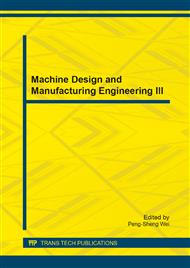p.577
p.581
p.588
p.594
p.600
p.604
p.608
p.612
p.616
Analysis of the Dynamic Characteristics of the Aerostatic Journal Bearings
Abstract:
This paper investigates the dynamic characteristics of the aerostatic journal bearing, the rotation center of which is not the center of the journal length. The Finite Difference Method (FDM) and the perturbation method are employed to calculate the stiffness and damping coefficients. Results show that the coupled stiffness and damping coefficients cannot be neglected due to the rotation center being not the center of the journal length. Furthermore, with the increase of the distance between the rotation center and the center of the journal length, the coupled stiffness and damping coefficients increase.
Info:
Periodical:
Pages:
600-603
Citation:
Online since:
July 2014
Authors:
Price:
Сopyright:
© 2014 Trans Tech Publications Ltd. All Rights Reserved
Share:
Citation:


